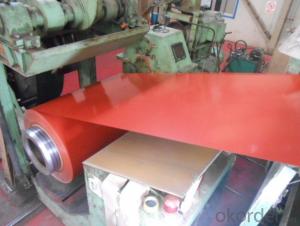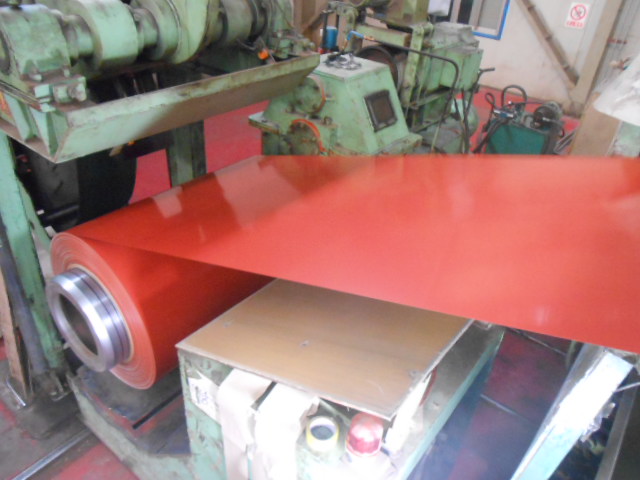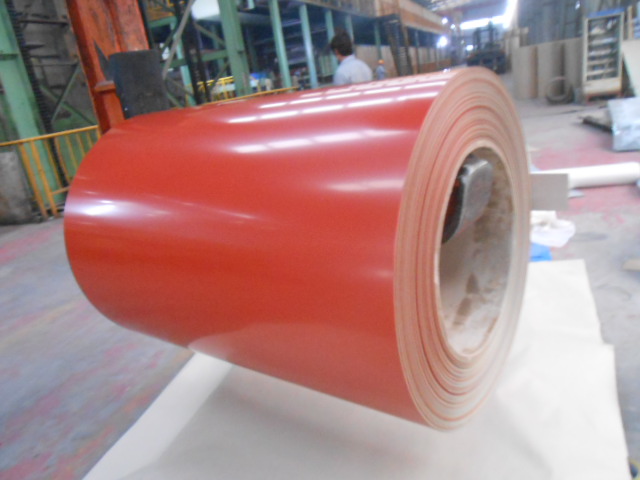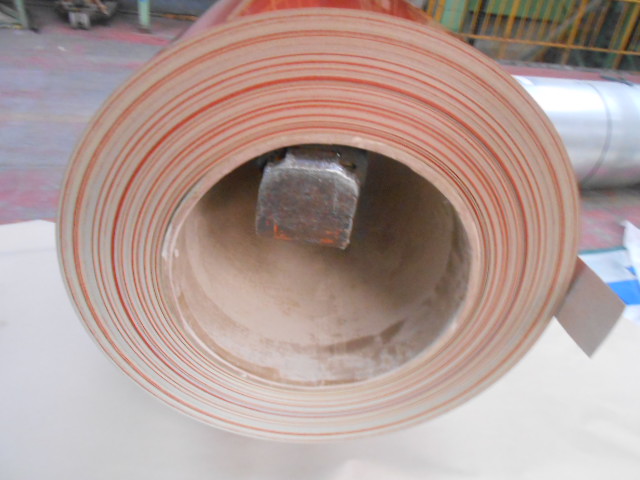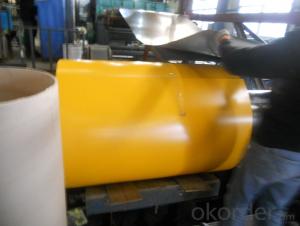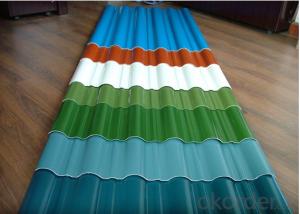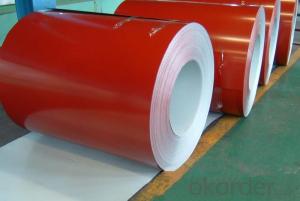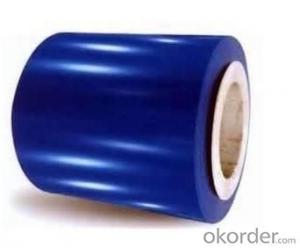Pre-Painted Galvanized Steel---Brick Red
- Loading Port:
- Tianjin
- Payment Terms:
- TT OR LC
- Min Order Qty:
- 100 m.t.
- Supply Capability:
- 10000 m.t./month
OKorder Service Pledge
OKorder Financial Service
You Might Also Like
1. Pre-Painted GI/GL Steel Coil Description:
With GI as base material, after pretreatment (degrease and chemical treatment ) and liquid dope with several layers of color, then after firing and cooling, finally the plate steel is called pre-painted galvanized (aluzinc) steel. Pre-painted galvanized steel is good capable of decoration, molding, corrosion resistance. It generally displays superior workability, durability and weather resistance.
2.Main Features of the Pre-Painted GI/GL Steel Coil:
• Excellent process capability
• Smooth and flat surface
• Workability, durability
• Excellent heat resistance performance
• High strength
• Good formability
• Good visual effect
3.Pre-Painted GI/GL Steel Coil Images
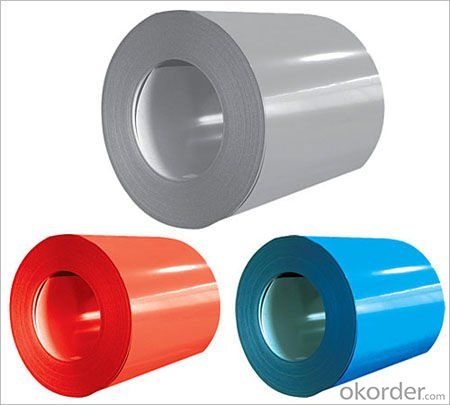
4.Pre-Painted GI/GL Steel Coil Specification
Standard: AISI, ASTM, BS, DIN, GB, JIS
Grade: DX51D, DX52D
Thickness: 0.17-2.0mm
Brand Name: KMRLON
Model Number: coil
Type: Steel Coil
Technique: Cold Rolled
Surface Treatment: Coated
Application: Boiler Plate
Special Use: High-strength Steel Plate
Width: 20-1250mm
Length: customized
commoidty: pre-painted galvanized steel coil
Thickness: 0.13-4.0mm
width: 20-1250mm
zinc coating: 40-180g/m2
printing thickness: top side: 20+/-5 microns, back side: 5-7 microns
color: all RAL color
surface treatment: color coated
coil weight: 4-7 tons
coil ID: 508/610mm
packaging: standard seaworthy packing
5.FAQ of Pre-Painted GI/GL Steel Coil
1. What’s the application of this product?
Roof, roof structure, surface sheet of balcony, frame of window, etc.
2. What’s the brand of the paint?
We use the best brand of all of the word—AKZO.
3. How to guarantee the quality of the products?
We have established the international advanced quality management system,every link from raw material to final product we have strict quality test;We resolutely put an end to unqualified products flowing into the market. At the same time, we will provide necessary follow-up service assurance.
4. How long can we receive the product after purchase?
Usually within thirty working days after receiving buyer’s advance payment or LC. We will arrange the factory manufacturing as soon as possible. The cargo readiness usually takes 15-25 days, but the shipment will depend on the vessel situation.
- Q: How are steel coils coated for specific applications?
- Steel coils are coated for specific applications through a process called coil coating. This involves applying a protective layer of paint, polymer, or other coatings onto the steel coils using methods like roll coating or spray coating. The coating is carefully selected based on the desired properties such as corrosion resistance, durability, or aesthetic appeal required for the specific application.
- Q: Are steel buildings or homes better then wooden buildings? Why?
- Benefits of steel buildings compare to wooden buildings are: ? Strength - Metal offers an overall strength level from within, a strength that other materials can't provide, without the need of extra support beams or other extraneous materials. ? Durability - Morton Buildings are longer lasting than those made from plastic or wood, and they can withstand adverse weather conditions without danger of rotting or mildew. ? Recyclable Materials - If a building is torn down, the materials used in Morton Buildings are capable of being reused and recycled, making Morton Buildings more sustainable than others. ? Stylistic Options - Because metal can be coated with other materials at little cost, the options for color and coating are virtually endless. Materials frequently used to coat metal building include vinyl or plastic. ? Affordability - Building with steel is one of the most affordable choices a consumer can make, be it a large or small project. These benefits are numerous, though there are a few factors to keep in mind when choosing your building materials. There may also be a few downsides or cons to Morton Buildings. I think steel Buildings are good for use in : ? Metal sheds ? Metal industrial parks ? Metal barns ? Aircraft carrier buildings ? Carrier and livestock buildings ? Retail stores
- Q: What are the common packaging methods for steel coils?
- The common packaging methods for steel coils include wooden pallets, steel strapping, and protective wrapping such as shrink wrap or stretch film. Additionally, steel coils are often secured with steel bands or wire ties to ensure stability during transportation and storage.
- Q: How are steel coils used in the production of HVAC systems?
- Steel coils are used in the production of HVAC systems as they serve as the primary component for heat transfer. These coils are responsible for absorbing heat from the surrounding air and transferring it to cool the interior of a building. Additionally, steel coils are used for the condenser coils in HVAC systems, where they aid in the removal of heat from the refrigerant, allowing for efficient cooling and dehumidification.
- Q: Can steel coils be cut or trimmed after delivery?
- Yes, steel coils can be cut or trimmed after delivery. This process is commonly known as slitting, where the steel coil is passed through a set of circular blades to create narrower strips of steel. Trimming can also be conducted to remove any unwanted edges or imperfections. Both cutting and trimming are common practices in the steel industry to meet specific size and shape requirements for various applications.
- Q: How are steel coils used in the production of industrial valves?
- Steel coils are used in the production of industrial valves as they are typically cut and formed into various components, such as valve bodies and stems. The coils provide a strong and durable material for the valves, ensuring their reliability and longevity in industrial applications.
- Q: I feel really stupid asking this question but i feel like a put metal/steel strings on my classical guitar how do you tell the difference?
- you do NOT want to put steel strings on a nylon string guitar, it will ruin it. It does get a little confusing. With steel strings, all 6 strings are metal. (usually steel, but not always, nickel, copper may be used too) And they use a steel core. with nylon strings, the high 3 strings, are obviously nylon/plastic. the 3 bass strings look metal, but they have a silk type core, with metal wrapped around it. The steel strings have a LOT more tension,, they can break the plastic tuners, beak the nut, pull the top up, and pull the bridge off, If you're not sure yet, have a real music store explain it, not a toy store, or costco or walmart.
- Q: How are steel coils cleaned?
- Steel coils are typically cleaned using a combination of processes such as chemical cleaning, mechanical cleaning, and/or high-pressure water blasting. The specific method used depends on the type and extent of dirt or contaminants present on the coils. Chemical cleaning involves applying specialized cleaning agents to dissolve and remove dirt, oil, or other substances. Mechanical cleaning may involve scrubbing or brushing the coils to physically remove debris. High-pressure water blasting is often employed to remove tough residues or surface impurities. The cleaning process aims to ensure that the steel coils are free from any contaminants before further processing or usage.
- Q: Aluminum alloy rolling doors and color steel shutter door that good
- Among them, aluminum alloy rolling doors and ordinary rolling doors, both from the appearance, environmental protection or safety, have considerable advantages. Aluminum Alloy doors can be sprayed on the surface of various colors and patterns, but also with the concavity of the wood, sand grain coated, highlight the noble temperament, improve grades, if it is used in shops, you can let your talent shows itself in many shops in the.
- Q: What are the different methods of blanking steel coils?
- There are several methods for blanking steel coils, including shearing, laser cutting, and waterjet cutting. Shearing involves using sharp blades to cut the coil into desired shapes. Laser cutting utilizes a high-powered laser beam to accurately cut through the steel. Waterjet cutting involves the use of a high-pressure stream of water mixed with abrasive materials to cut the coil. These methods offer different levels of precision, speed, and cost-effectiveness depending on the specific requirements of the blanking process.
Send your message to us
Pre-Painted Galvanized Steel---Brick Red
- Loading Port:
- Tianjin
- Payment Terms:
- TT OR LC
- Min Order Qty:
- 100 m.t.
- Supply Capability:
- 10000 m.t./month
OKorder Service Pledge
OKorder Financial Service
Similar products
Hot products
Hot Searches
Related keywords
